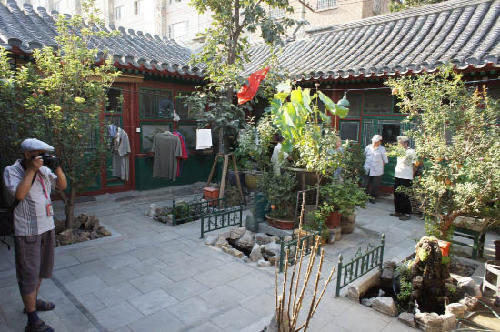Beijing’s Green Courtyard
 |
| During the renovations, the courtyard was paved with water permeable bricks. |
“This courtyard was passed down from my grandfather. It is home to three generations of our family,” said the courtyard’s owner, Chen Geng. “Three years ago, it became dilapidated and wasn’t fit for living in, so I decided to knock it down and rebuild it.”
After surveying the construction, Sino-Ocean Land Holdings Ltd. concluded that the construction needed moderate repairs instead of full-scale reconstruction. Its proposal included the courtyard’s inclusion into its zero-carbon demonstration project, which has sponsored environmental renovation in over 100 communities so far, and covers all expenses. In the courtyard, the alterations consisted of three parts – rainwater collection and recycling, the construction of an artificial wetland for wastewater treatment and adaptations to the courtyard environment – aiming to make the old courtyard livable as well as environmentally friendly in the areas of water conservation, emission reduction and environmental improvement.
The original courtyard had no water-saving facility. During the renovations, the courtyard was paved with water permeable bricks. “They look like ordinary gray bricks but are actually made of a special material with extraordinary permeability,” Chen Geng explained. “No matter how heavy the rain is, puddles of stagnant water never form.”
In this water collection area, which is essentially a well, the elevation facade is tiled with seepage-control bricks that guarantee rain flows to the floor. The base is a layer of sand about 50 millimeters thick, air permeable but waterproof, which can prolong the quality guarantee period of the collected rainwater. “The natural rainwater is first channeled to the well,” Chen Geng said. “After several rounds of filtration, it is used to irrigate flowers and plants and in fish ponds.”
“Preliminary calculations show that the system can collect and process as much as eight tons of rainwater annually,” explained Wang Yutian, a staff member at the Strategic Development Department of Sino-Ocean Land, “and the maintenance cost is next to nothing.”
Artificial Wetland
“Compared with previous projects, the highlight of this one is the ‘artificial wetland’ technology that we have adopted for the first time in transforming old constructions,” said Tu Zheng, general designer of the courtyard from Sino-Ocean Land’s R&D Department. “The collecting, recycling, filtrating and extracting systems allow the waste water to be used in the courtyard for aquatic plants and fish tanks; thus, water is saved and the environment is improved at the same time.”
The artificial wetland system usually consists of artificial soil and aquatic plants. It is a special eco-system including soil, plants and microbes. “Family wastewater (sewerage from the flush toilet excluded), including water for personal sanitation and washing clothes, is pumped to the wetland in the courtyard. After biological cleaning, it is directed through pipelines for usage. Though not potable, it can be used to flush toilets and clean floors,” said Chen Geng.


- Are You Ready to Perform?
- Beijing’s Green Courtyard
- China’s CSR on the Global Market Fast Track – An Interview with Xu Zongxiang, vice president of China South Locomotive & Rolling Stock Corporation Limited (CSR)
- China’s Changing Development Pattern
- China Accelerates Transformation of Its Economic Development Model
Services
Economy
- Are You Ready to Perform?
- Beijing’s Green Courtyard
- China’s CSR on the Global Market Fast Track – An Interview with Xu Zongxiang, vice president of China South Locomotive & Rolling Stock Corporation Limited (CSR)
- China’s Changing Development Pattern
- China Accelerates Transformation of Its Economic Development Model
